| 摘要: |
| [目的]分析城镇化与耕地利用之间的动态关系,促进新型城镇化与农业现代化协调发展。[方法]在综合选取城镇化与耕地利用集约化代表性指标的基础上,运用向量自回归模型(VAR)检验城镇化与耕地利用集约化之间的协整关系,运用脉冲响应分析及方差分解检验两者之间的互馈关系。[结果]2000—2016年重庆市城镇化与耕地利用集约化之间存在稳定的均衡关系; 复种指数对城镇化人口比例由最初的负向效应逐渐转变为正向影响,对其余指标表现为正向影响,方差分解结果显示其对上述指标在第八期总贡献率达70%,复种指数对自身影响较大,解释水平较高; 化肥对二、三产业比例、土地城镇化表现为负向影响,对其他指标影响较小; 农业机械总动力对人口城镇化表现为正向影响,对二、三产业比例、土地城镇化及自身有负向影响。二、三产业比例的冲击对化肥投入冲击的贡献率基本保持在11%~14%之间,城镇人口比例、二、三产业比例及土地城镇化总贡献率不断上升。城镇人口比例、二、三产业比例及土地城镇化对农业机械总动力冲击的贡献率差异较大,其中城镇人口比例对其贡献率基本保持在20%左右,后期变化较小。[结论]综合来看,城镇化水平的稳步提高能够正向推动耕地利用集约化,而耕地利用集约化对城镇化水平的提高仅具有较小的正向影响。 |
| 关键词: 城镇化耕地利用集约化影响VAR模型重庆市 |
| DOI: |
| 分类号:F29927,F323211 |
| 基金项目:国家农村领域科技计划课题项目“山地传统民居特色文化资源与空间协同共生关键技术与示范”(2013BAJ11B04 04) |
|
| ANALYSIS OF DYNAMIC RESPONSE AND INFLUENCING FACTORS OF INTENSIFICATION OF URBANIZATION AND ARABLE LAND UTILIZATION*——A CASE STUDY OF CHONGQING |
|
Zhang Wei
|
|
Chongqing Jiaotong University, Chongqing 400074,China
|
| Abstract: |
| The dynamic relationship between urbanization and arable land use is analyzed to promote the coordinated development of new urbanization and agricultural modernization. Based on the comprehensive selection of representative indicators of urbanization and arable land use, vector autoregression model (VAR) was used to test the cointegration relationship between urbanization and intensive use of arable land. And the impulse response analysis and variance decomposition were used to examine the mutual feedback relationship between urbanization and intensive use of arable land. The results of the study indicated that there was a stable equilibrium relationship between the urbanization of Chongqing and the intensive use of arable land from 2000 to 2016.The multiple crop index gradually changed from the initial negative effect to the positive impact on the proportion of urbanized population, and for other indicators, the performance was positive. The result of variance decomposition showed that the total contribution rate of the above indicators in the eighth period reached 70%. The multiple crop index had a greater impact on oneself and a higher level of interpretation. The ratio of chemical fertilizers had negative impact on the secondary, tertiary industries and land urbanization and it had little impact on other indicators. The total power of agricultural machinery had a positive effect on the urbanization of the population, and a negative impact on the proportion of secondary and tertiary industries, urbanization of the soil, and itself. The impact of the ratio of secondary and tertiary industries on the input of chemical fertilizer input had basically remained between 11% and 14%. The proportion of urban population, secondary and tertiary industries, and the total contribution of land to urbanization were rising. The contribution rate of the proportion of urban population, secondary and tertiary industries, and urbanization of the soil to the total power of agricultural machinery was quite different, the contribution rate of the urban population to its contribution rate basically maintained at about 20%, with little change in the later period. Generally speaking, the steady improvement in the level of urbanization can positively promote the intensive use of cultivated land, while the intensive use of arable land has only a small positive impact on the improvement of urbanization. |
| Key words: urbanization cultivated land use intensification influence vector autoregression model Chongqing |

